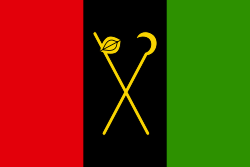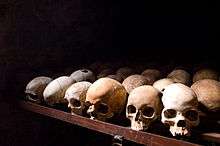Interahamwe
| Interahamwe | |
|---|---|
|
Participant in Rwandan Genocide First Congo War Second Congo War | |
 Flag of the Interahamwe | |
| Active | 1994–present |
| Ideology | Hutu Power |
| Leaders |
Augustin Bizimungu Tharcisse Renzaho Idelphonse Hategekimana Idelphonse Nizeyimana Protais Mpiranya Callixte Nzabonimana Aloys Ndimbati |
| Area of operations | Jungles of Uganda and the Democratic Republic of the Congo; formerly Rwanda |
| Size |
100,000 (1994) 20,000 (1998) 6,500 (2012) |
| Allies |
Impuzamugambi FDLR (2000–present) |
| Opponents |
|
 Human skulls at the Nyamata Genocide Memorial Centre |
| Part of a series on the |
| Rwandan genocide |
|---|
|
Parties responsible |
|
Resources |
The Interahamwe is a Hutu paramilitary organization. Originally the youth wing of ruling party of Rwanda, the MRND, during the Rwandan Genocide the term "Interahamwe" widened to mean any civilian bands killing Tutsi.[1][2] The militia enjoyed the backing of the Hutu-led government leading up to and during the genocide. Since the genocide, they have been driven out of Rwanda, mainly to Zaire (present day Democratic Republic of the Congo). They are considered a terrorist organisation by most Western governments, as well as several countries in Africa (including Rwanda, the Democratic Republic of the Congo, and several others).
Etymology
The name Interahamwe can be translated as "those who work together" or loosely as "those who fight together".[3] Work was used as slang in racist radio broadcasts during the genocide—"working" meant using machetes to kill.[4] The name Interahamwe can be broken up as follows: intera is derived from the verb gutera, meaning "to work"; hamwe means "together" and is related to the word rimwe for "one".
English speakers usually pronounce it as /ˌɪntərəˈhɑːmweɪ/, though it is pronounced [inhêːɾɑhɑ́mwe] in Kinyarwanda. However, when speaking English, Rwandans will sometimes pronounce it in the English manner. The difference can be observed by listening to Paul Rusesabagina in the Return to Rwanda feature of a Hotel Rwanda DVD, and to the translator for a survivor of the Nyarubuye massacre in "Frontline" Ghosts of Rwanda.
Organisation and history
Robert Kajuga, a Tutsi (unusual for this group),[5] was the president of the Interahamwe. The vice president of Interahamwe was Georges Rutaganda. The Interahamwe was formed from groups of young people of the MRND party. They carried out the Rwandan Genocide against the Tutsis in 1994. The radio station RTLM, founded by Rwandan president Juvénal Habyarimana and his wife, was popular amongst the Interahamwe for its decidedly pro-Hutu agenda, among other things. From October 1993 to late 1994, it was used as an outlet for extremists to release ethnocentric and xenophobic propaganda targeted at the Tutsis, moderate Hutus and Belgians.[6] Often it encouraged the ongoing acts of genocide by promoting fear among the Hutus that the Tutsis would massacre them, and broadcasting the positions of Tutsis hiding or attempting to flee.[6]
Following the invasion of the Rwandan capital Kigali by the Tutsi Rwandan Patriotic Front (RPF), many Rwandan civilians and members of the Interahamwe fled to neighbouring countries, most notably to what at the time was Zaire, now Democratic Republic of Congo, and Tanzania. Sudan welcomed former Interahamwe to Juba, and in March 1998, Colonel Tharcisse Renzaho, the former prefect of Kigali, and Colonel Ntiwiragabo, the former Rwandan Presidential Guard commander, arrived in Juba from Nairobi to organize them.[7] It has been nearly impossible to bring the Interahamwe to justice because they did not wear uniforms or have a clearly organized group of followers. They were the neighbours, friends and co-workers of Tutsis. Throughout the war, members of the Interahamwe moved into camps of refugees and the internally displaced. There the victims were mixed in with the enemy making it difficult to prosecute members of the Interahamwe. But the Gacaca court was put in place to at least attempt to get the killers in jail. It has seen criticism from many different sources for being flawed with the judges having inadequate training and many different parties in the court system being corrupt. This problem has led to many innocent people being put in jail and has caused the prisons to become overcrowded.
During the war, millions of Rwandan Hutu refugees fled to Zaire (now the Democratic Republic of the Congo), along with many members of the Interahamwe, Presidential Guard and the Rwandan Government Forces (RGF). Following the recruitment of significant numbers of Congolese Hutu the organisation took the name Armée de Libération du Rwanda (ALiR). With the Kagame regime still in power, members still take part in border raids from the refugee camps.
Post–Rwandan Genocide
In 1999, Interahamwe attacked and kidnapped a group of 14 tourists in Bwindi National Park, Uganda. Eight of the tourists were killed.[8] The story was featured on National Geographic, Locked Up Abroad: Uganda.[9]
Prosecution
Leaders of the Interahamwe have been primarily prosecuted through the International Criminal Tribunal for Rwanda in Arusha, Tanzania. The tribunal has convicted at least 41 persons, often with life sentences, including former interim Prime Minister Jean Kambanda and Georges Rutaganda.[10] Fugitives have been captured and prosecuted in other countries, including Jean-Marie Vianney Mudahinyuka (a.k.a. "Zuzu"), an Interahamwe leader found hiding in Chicago, Illinois in January 2011.[11][12][13]
References
- ↑ Reyntjens, Filip (21 October 2014). "Rwanda's Untold Story. A reply to "38 scholars, scientists, researchers, journalists and historians"". African Arguments.
- ↑ Des Forges, Alison (March 1999). Leave None to Tell the Story: Genocide in Rwanda – The Organization → The Militia. New York: Human Rights Watch. ISBN 1-56432-171-1.
- ↑ "Rwanda: How the genocide happened". BBC News. 17 May 2011.
- ↑ Bührer, Michel (1996). Rwanda : Memoire d'un génocide. Paris: Editions UNESCO. p. 12.
- ↑ Vasagar, Jeevan (16 February 2005). "The hotel that saved hundreds from genocide". The Guardian.
- 1 2 "Rwanda radio transcripts". www.concordia.ca. Retrieved 2017-02-28.
- ↑ Gérard Prunier, From Genocide to Continental War: The "Congolese" Conflict and the Crisis of Contemporary Africa, C. Hurst & Co, 2009, ISBN 1-85065-523-5, p. 193
- ↑ "BBC News - Africa - Kidnap tourist tells of ordeal". Retrieved 20 January 2015.
- ↑ "Locked Up Abroad". National Geographic Channel. Retrieved 20 January 2015.
- ↑ "Home - United Nations International Criminal Tribunal for Rwanda". Archived from the original on 9 September 2015. Retrieved 20 January 2015.
- ↑ https://www.ice.gov/news/releases/ice-deports-rwandan-wanted-committing-war-crimes-during-1994-genocide
- ↑ Guzzardi, Will (2 February 2011). "Suspected Genocide Leader Deported From Chicago To Rwanda". Huffington Post.
- ↑ Don Terry (June 26, 2005). "The Man Called Zuzu". Chicago Tribune.
| Hutu militants |
|---|
| Rwandan genocide (1994) |
| Impuzamugambi |
| Interahamwe |
| Rwandan Armed Forces |
| Refugee crisis |
| RDR (1995–1996) |
| 1st and 2nd Congo War |
| ALiR (1996–2001) |
| FDLR (2000–present) |